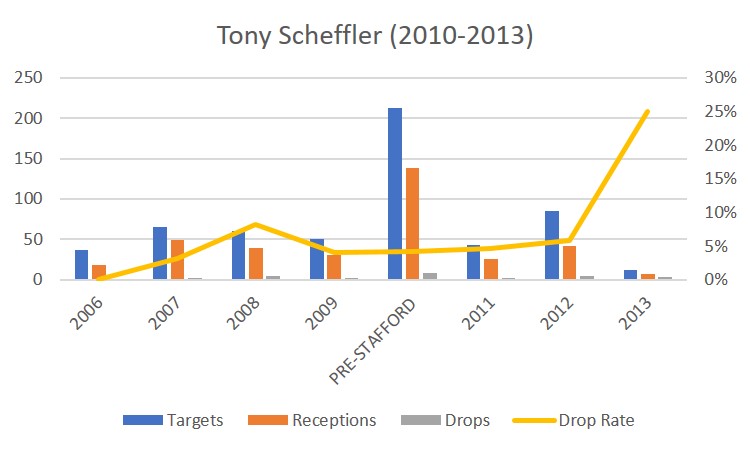The Lions receiving corps was mired by drops all season long in 2016 and it was probably worse than you remember. Detroit was the only team to place their top four pass-catchers in the top 40 of dropped passes. Eric Ebron (6th), Marvin Jones (12th), Golden Tate (34th), and Anquan Boldin (37th) all made the list. No other team even placed three of their top four.
Only seven other teams (Houston, Los Angeles, Philadelphia, Pittsburgh, San Diego, and both New York teams) had two. The only unit that came close to being as bad as Detroit was Philly, with Nelson Agholor (41st) and Dorial Green-Beckham (44th) falling just outside of the top 40. Eagles fans don’t like Agholor very much. DGB is a free agent.
Yikes.
So What Gives?
In September 2016, MLive’s Kyle Meinke implicated an unlikely culprit as the reason behind the drops that have plagued the various receiving corps throughout the years: the quarterback. “Stafford struggled some early in his career to take heat off the ball, which some thought might be why Detroit’s receivers would struggle with drops,” Meinke wrote.
But at the time, Meinke – like so many others, myself included – didn’t seem worried about it. “The Lions have helped counter this dynamic by adding receivers who are known for having exceptional hands,” he wrote. “Tate was the league’s surest-handed wideout when he signed with Detroit in 2014, and Marvin Jones and Anquan Boldin, this year’s big additions, are reliable as well.”
Both Jones and Boldin were both coming off seasons in which they posted a sub-2% drop rate. Yet, each saw those percentages dramatically spike after arriving in Detroit. So, is Stafford’s arm really that powerful?
Golden Tate seems to think so.
Tate’s Theory
“I think Matt has great touch, but sometimes the speed can be tough,” Tate said. “You’ve got to be able to catch on this team,” he continued, “Some of these receivers throughout the NFL are receiving passes from softer to very soft throwing quarterbacks that I don’t think could play here. Or maybe they could, but it would take a while to get used to that.”
But, does the data support that hypothesis? Using dropped pass statistics from SportingCharts.com, I compared the drop rates of former and current Lions during their Detroit years to the drop rates at their various other career stops.
The Criteria
The criteria was as follows: the player must have been a WR, TE, or RB who played at least one (1) season with Detroit and at least one (1) season with another team, and the player must have been targeted at least 40 times in at least one (1) season with Detroit and in at least one (1) season with another team.
Research indicated that there were seven eligible players: Nate Burleson, Tony Scheffler, Reggie Bush, Golden Tate, Lance Moore, Anquan Boldin, and Marvin Jones.
Statistics were not used for Lions players who were with the team during 2010 because Stafford only played three games that year due to injury. (E.G. 2011 is considered as Burleson’s first season ‘with Stafford.’)
I calculated a player’s ‘Without Stafford’ drop rate by dividing their total drops by their total targets from all pre- and post-Detroit stops. I used the same method for their ‘With Stafford’ drop rate using the data from their season(s) in Detroit.
The average increase was almost a full percentage point (0.9%) over their ‘Without Stafford’ drop rates. Only Golden Tate and Lance Moore posted lower drop rates With Stafford than Without him. That statistic would seem to prove Tate’s assertion correct.
Without Stafford vs. With Stafford
When you compare the first year catching passes from Stafford to the previous season ‘without Stafford’, the results are mixed. Three players – Bush (-0.2%), Tate (-0.6%), and Moore (-15.4%), and Bush – saw their drop rate decrease season-over-season during their first year. (Furthermore, none of the eligible players – besides Marvin Jones – have posted a career-high drop rate while in Detroit.)
The other four – Burleson (+5.3%), Scheffler (+0.7%), Boldin (+2.4%), and Jones (+3.9%) – struggled, to varying degrees, to adjust to the velocity of Stafford’s passes. (Furthermore, none of the eligible players – besides Marvin Jones – have posted a career-high drop rate while in Detroit.)
Of those four, only two (Burleson and Scheffler) recorded more than one season with the team. One of them seemed to adjust well, the other did not. Burleson’s drop rate went from 9.1% in 2011 to 2.3% in 2012 and then 3.7% in 2013.
Players With Three-Plus Years in Detroit

Scheffler’s drop rate went from 4.7% in 2011 to 5.9% in 2012 before ultimately ballooning to 25% in 2013. He subsequently retired midway through the season due to concussion problems.
Tate, who has also accrued three seasons with the team, has seen his drop rate steadily increase since arriving in Detroit in 2014. His 2016 drop rate of 3% was more than double that of his first year with the team (1.4%).
Lance Moore is likely an aberration in this instance, as is Tony Scheffler’s 2013 season. Discounting both Moore and Scheffler’s 2013 season, the average drop rate of the other six players is 4.3% with Stafford and 5.5% without. The data, for the most part, suggests that Tate’s theory is likely correct.
However, it’s nevertheless inconclusive, at least with respect to his claim about the first-year adjustment period. Marvin Jones and Tate himself should prove to be valuable case studies moving forward. Until then, I leave you to draw your own conclusions.






